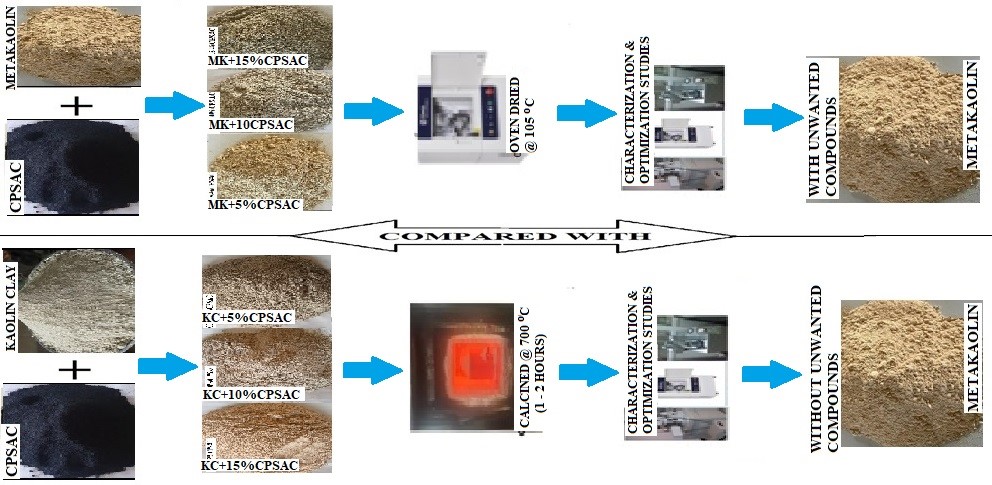Potential of Carica Papaya Stem Activated Carbon in Removal of Undesired Compounds from Metakaolin
DOI:
https://doi.org/10.48048/tis.2024.7457Keywords:
Activated carbon, Calcination process, carica papaya stem, Kaolin clay, MetakaolinAbstract
Metakaolin (MK) is a pozzolan exhibiting additional cementitious tendency and is made by dehydroxylating Kaolin Clay (KC). In this study,potential of Carica papaya Stem Activated Carbon (CPSAC) in removal of undesired compounds or impurities from MK was examined.Carica papaya Stem (CPS) was processed into powder and chemically activated using hydrochloric (HCl) acid, while MK was produced from KC through calcination process.Five conical flasks contained 5 to 25 % CPSAC at 5 % weight intervals. Two hundredg of MK or KC was added and well mixed to achieve homogeneity.The KC+CPSAC samples were subjected to calcination inside a muffle furnace at 700 °C and removed after 1 to 2 h then allowed to cool; while the MK+CPSAC samples were soaked in water (125 mL for each sample) for 24 h, thereafter oven-dried at 105 °C. Subsequently, the samples obtained were subjected to Scanning Electron Microscopy (SEM) analysis to investigate their surface morphology, while X-Ray Diffraction (XRD) and X-Ray Fluorescence (XRF) techniques were employed to ascertain their chemical and mineralogical compositions, respectively.The data obtained from chemical composition analyses were thereafter subjected to optimization studies.The SEM plates showed thatthe sizes of all thesamples were within ranges of 2 and 50 nm, and their intensity pinnacles from XRD plots ranged between 200 and 4000 cps. CPSAC (21.42%) eliminated the unwanted compounds in the MK andincreasethe amount of its major oxides (Al2O3, CaO, SiO2 and Fe2O3by 43.76,16.89, 12.76, 6.51 %, respectively). In conclusion, CPSAC showed potential as a viable industrial treatment material for MK.
HIGHLIGHTS
- Remediation of unwanted compounds from MK
- CPSAC’s efficacies in soil (MK) remediation
- Treatment effects of calcination process and agricultural adsorbent on MK
- Optimization studies of MK compounds
GRAPHICAL ABSTRACT

Downloads
Metrics
References
AA Raheem, R Abdulwahab and MA Kareem. Incorporation of metakaolin and nanosilica in blended cement mortar and concrete - A review.J. Cleaner Prod. 2021; 290, 125852.
DL Pillay, OB Olalusi, PO Awoyera, C Rondon, AM Echeverria and JT Kolawole. A review of the engineering properties of metakaolin based concrete: Towards combatting chloride attack in coastal/marine structures. Adv.Civ. Eng. 2020; 2020, 8880974.
I Sánchez, ISD Soto, M Casas, RVDL Villa and R García-Giménez. Evolution of metakaolin thermal and chemical activation from natural kaolin. Minerals2020; 10, 534.
BB Jindal, T Alomayri, A Hasan and CR Kaze. Geopolymer concrete with metakaolin for sustainability: A comprehensive review on raw material’s properties, synthesis, performance, and potential application. Environ. Sci. Pollut. Res. 2022; 30, 25299-324.
R Abdulwahab, SO Odeyemi, HT Alaoand TA Salaudeen. Effect of metakaolin and treated rice husk ash on compressive strength of concrete. Res. Eng. Struct. Mater. 2021; 7, 199-209.
EA Adetoro, R Abdulwahab, OD Adetoro, SO Ojoawo and P Naik. Treatment effect on reactivity of metakaolin using Azadirachta indica bark activated carbon.Mater. Today Proc. 2023; 88, 119-27.
F Zunino and K Scrivener. The reaction between metakaolin and limestone and its effect in porosity refinement and mechanical properties.CementConcr. Res.2021; 140, 106307.
MA Keerio, A Saad, A Kumar, N Bheel and K Ali. Effect of local metakaolin developed from natural material soorh and coal bottom ash on fresh, hardened properties and embodied carbon of self-compacting concrete. Environ. Sci. Pollut. Res.2021; 28, 60000-18.
HM Hamada, BA Tayeh, A Al-Attar, FM Yahaya, K Muthusamy and AM Humada. The present state of the use of eggshell powder in concrete: A review.J. Build. Eng.2020; 32, 101583.
N Bheel, MOA Ali, T Tafsirojjaman, SH Khahro and MA Keerio. Experimental study on fresh, mechanical properties and embodied carbon of concrete blended with sugarcane bagasse ash, metakaolin, and millet husk ash as ternary cementitious material. Environ. Sci. Pollut. Res.2022; 29, 2554-39.
TJ Afolayan, OA Adetoye and A Sani. A review on the effect of pozzolanic properties of metakaolin in concrete. Int. J. Res. Publ. Rev.2022; 3, 1383-8.
GL Thankam and NT Renganathan. Ideal supplementing cementing material - Metakaolin: A review.Int. Rev. Appl. Sci. Eng.2020; 11, 58-65.
KM Ibrahim, MK Moumani and SK Mohammad. Extraction of ϒ-alumina from low-cost kaolin. Resources 2018; 7, 63.
EA Adetoro, SO Ojoawo and AM Salman. Adsorption and desorption studies of Carica papaya stem activated with zinc chloride in mining wastewater treatment. Water SA2022; 48, 187-98.
AE Adetoro and SO Ojoawo. Optimization study of biosorption of toxic metals from mining wastewater using Azadirachta indica bark. Water Sci. Tech. 2020; 82, 887-904.
X Bai, S Wen, J Liu and Y Lin. Response surface methodology for optimization of copper leaching from refractory flotation tailings. Minerals 2018; 8, 165.
Stat Ease.Design expert software version 13, Available at: http://www.statease.com, accessed November2022.
YO Abiodun, JI Orisaleye and SO Adeosun. Effect of calcination temperatures of kaolin on compressive and flexural strengths of Metakaolin concrete. Niger. J. Tech. Dev.2023; 20, 33-43.
O Burciaga-Diaz andJI Escalante-Garcia. Structural transition to well-ordered phases of NaOH-activated slag-metakaolin cements aged by 6 years. Cement Concr. Res.2022; 156, 106791.
A Pallares-Rusiñol, M Bernuz, SL Moura, C Fernández-Senac, R Rossi, M Marti and MIPividon. Advances in exosome analysis.Adv. Clin. Chem.2023; 112, 69-117.
N Raval, R Maheshwari, D Kalyane, SR Youngren-Ortiz, MB Chougule and RK Tekade. Importance of physicochemical characterization of nanoparticles in pharmaceutical product development. In: Basic fundamentals of drug delivery. Academic Press, Cambridge, 2019, p. 369-400.
E Nossol, RAA Muñoz, EM Richter, PHDS Borges, SC Silva and DP Rocha. Sensing materials: Graphene. Encyclopedia Sensor. Biosens. 2023; 2, 367-88.
YJ Choi and K Sawada. Physical sensors: Fluorescence sensors. Encyclopedia Sensor. Biosens. 2023; 1, 1-19.
Q Wang, Y Wang, Z Yang, W Han, L Yuan, L Zhang and X Huang. Efficient removal of Pb(II) and Cd(II) from aqueous solutions by mango seed biosorbent. Chem. Eng. J. Adv. 2022; 11, 100295.

Downloads
Published
How to Cite
Issue
Section
License
Copyright (c) 2023 Walailak University

This work is licensed under a Creative Commons Attribution-NonCommercial-NoDerivatives 4.0 International License.






